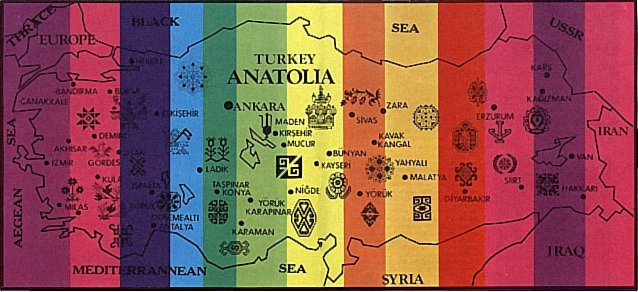Oriental Rugs &
Kilims
The art of carpet
weaving which has been going on for the past 3500 years is one of the oldest
professions in the world. In the warm climate of the civilizations within the
fertile crescent-Assyrian, Babylonian, Egyptian and partly Hellenistic- weaving
tended to produce clothes and was concentrated more on embroidery than on
carpetry, in contrast with the peoples of central Asia who produced carpets and
kilims with the aim of protecting themselves from the cold climate. Carpets
reflect the culture of a people and with their attractive colors and designs
convey artistic messages to peoples of other cultures, thus became a universal
means of discourse. When you observe their surface, lines and delieneate the
motifs in their repetituous rhythm, symmetrical harmony, dominance and
hierarchy, balance and unity, you will apreciate why carpet weaving is one of
the most beautiful artistic activities.
The art of Turkish carpet
weaving first started in central Asia. It underwent changes in design, but the
main characteristics remained intact. In the earlier examples, geometrical forms
like stars, squares, hexagons and octagons were dominant; roses or rose-like
forms and other floral patterns constituted the motifs. In the period following
the acceptance of islam, the mihrab (altar), the kandil (candle) and the ibrik
(pourer) became dominant figures, especially of the Turkish seccade ( the small
carpet used to pray on).
There are two main weaving
techniques in the world. The first is the Turkish technique which is called the
' gordes ' knotting system. Gordes means double-knot. The other is called the '
senneh ' which is the single knot technique. This is used in countries like
Iran, Afghanistan, Russia and China. The most important instrument in weaving is
the carpet-loom which is a wooden construction. Strings placed vertically and
horizontally on the loom form the skeleton of the carpet. Carpets are given
brightness and regularity by cutting the over rests of the knots on the
strings. During knotting, threads with desired colors are selected and woven in
accordance with the model. The quality of the carpet is increased as the number
of tied knots per cm square increases. All this demands utmost patience and
takes a great deal of time. It takes a year to weave a silken carpet proving the
truth of the proverb: fine things are hard...
There are three kinds of
meterial used in carpet weaving. Wool, cotton and silk. While some carpets are
woven with single type of material, a mix of them can also be used, such as,
wool on cotton or silk on wool. Most delicate carpets are the ones that are pure
silk. The quality of the carpet also depends on the dyes used. Traditionally,
natural dyes which are extracted from various plants are used and accepted as
valuable. These dyes have natural colors and last for centuries. However,
industrial carpets are produced with synthetic dyes are not preferred as
valuable.
 |
| Above map displays Anatolia on which
various types and regions of carpets are found. The colors and motifs on
the map depicts the actual colors and motifs used in Anatolian carpets
and kilims. As you can see weaving is largely scattered all over
Anatolia except the northern region at which the quality of the wool is
poor due to climate. |
Below i am presenting you some of the
pieces of carpets and kilims in my personal collection. These are only a small
part of my collection, the rest of which i will present here from time to time.
I have a large collection of most valuable specimens, all are aged and well
preserved. Apologizes for the low quality of the sample pictures. Please
feel free to contact me via following e-mails for detailed information about
each item.
dhepguler@mail.isbank.net.tr
borsaci06@hotmail.com
dhepguler@hotmail.com
 |
Carpets |
 |
Kilims |
 |
Bags
& Pillows |
<<< back to main menu...

